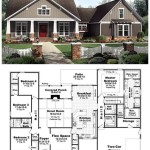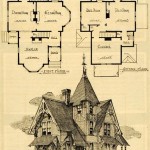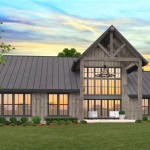A house plan with a loft design is an architectural blueprint that incorporates a large, open space above the main living area. This space is typically accessed by a staircase or ladder and can be used for a variety of purposes, such as a sleeping area, a home office, or a playroom. Loft designs are often found in modern homes and apartments, as they offer a unique and stylish way to maximize space.
One of the most common uses for a loft is as a sleeping area. This is a great option for people who want to have a separate space for sleeping, but who do not want to sacrifice square footage on the main floor. Lofts can also be used as home offices, as they provide a quiet and private space to work. Additionally, lofts can be used as playrooms or family rooms, as they offer a large, open space for children to play or for families to spend time together.
Regardless of how it is used, a loft can be a valuable addition to any home. It can provide extra space, privacy, and style, making it a popular choice for many homeowners.
When considering a house plan with a loft design, there are several important points to keep in mind:
- Space Optimization: Lofts maximize space by utilizing vertical space.
- Versatile Use: Lofts can serve various purposes, such as bedrooms, offices, or play areas.
- Abundant Light: Lofts often feature large windows, providing ample natural light.
- Privacy and Separation: Lofts offer a separate and private space within the home.
- Architectural Interest: Lofts add visual interest and architectural character to a home.
- Ceiling Height: Ensure sufficient ceiling height in both the main living area and the loft.
- Access and Safety: Consider the type of access to the loft (stairs, ladder) and safety measures (railing, lighting).
- Ventilation and Airflow: Proper ventilation and airflow are crucial for loft comfort.
- Building Codes: Comply with local building codes and regulations regarding loft design.
By carefully considering these points, you can create a house plan with a loft design that meets your specific needs and preferences.
Space Optimization: Lofts maximize space by utilizing vertical space.
One of the key advantages of a house plan with a loft design is its ability to maximize space. Lofts utilize vertical space, which would otherwise go unused, to create additional living area. This is especially beneficial in homes with limited square footage or in urban areas where land is at a premium.
- Increased Floor Area: By adding a loft, you can effectively increase the floor area of your home without expanding its footprint. This extra space can be used for a variety of purposes, such as creating an additional bedroom, a home office, or a playroom.
- Efficient Use of Space: Lofts are a very efficient use of space. They do not require any additional foundation or exterior walls, making them a cost-effective way to add extra living space to your home.
- Vertical Interest: Lofts add vertical interest to a home’s design. They can create a dramatic focal point in a living room or other main space.
- Natural Light: Lofts often feature large windows or skylights, which allow for ample natural light. This can help to create a bright and airy atmosphere in the loft and the main living space below.
Overall, lofts are an excellent way to maximize space in a home. They offer a variety of benefits, including increased floor area, efficient use of space, vertical interest, and natural light.
Versatile Use: Lofts can serve various purposes, such as bedrooms, offices, or play areas.
Another key advantage of a house plan with a loft design is its versatility. Lofts can be used for a variety of purposes, depending on the needs of the homeowner. This makes them a great option for people who want a home that can adapt to their changing needs over time.
- Bedrooms: Lofts are a popular choice for additional bedrooms, as they offer a private and separate sleeping space. This is especially beneficial for families with older children or guests who need their own space.
- Home Offices: Lofts can also be used as home offices, as they provide a quiet and private space to work. This is ideal for people who work from home or who need a dedicated space for their business.
- Playrooms: Lofts are a great option for playrooms, as they offer a large, open space for children to play. This can help to keep the main living areas of the home tidy and free of toys.
- Other Uses: In addition to the above, lofts can also be used for a variety of other purposes, such as libraries, art studios, or guest rooms. The possibilities are endless.
Overall, the versatility of lofts makes them a valuable addition to any home. They can be used to meet a variety of needs, making them a great option for people who want a home that is both functional and stylish.
Abundant Light: Lofts often feature large windows, providing ample natural light.
One of the most appealing features of a house plan with a loft design is the abundance of natural light that lofts often provide. This is due to the fact that lofts are typically located on the top floor of a home, where they have access to more direct sunlight. Additionally, lofts often feature large windows or skylights, which allow for even more natural light to enter the space.
Natural light has a number of benefits for both our physical and mental health. It can help to improve our mood, boost our energy levels, and increase our productivity. Additionally, natural light can help to reduce stress and anxiety. In a loft, natural light can help to create a bright and airy atmosphere, which can make the space feel more inviting and comfortable.
In addition to the benefits for our health and well-being, natural light can also help to reduce our energy consumption. By using natural light to illuminate our homes, we can reduce our reliance on artificial lighting, which can save us money on our energy bills. Additionally, natural light can help to keep our homes cooler in the summer and warmer in the winter, which can further reduce our energy consumption.
Overall, the abundance of natural light that lofts often provide is a major benefit of this type of home design. Natural light can improve our health and well-being, reduce our energy consumption, and create a more inviting and comfortable living space.
Privacy and Separation: Lofts offer a separate and private space within the home.
One of the key benefits of a house plan with a loft design is the privacy and separation that it offers. Lofts are typically located on the top floor of a home, which gives them a sense of seclusion and privacy. Additionally, lofts often have their own separate entrance, which can further increase the sense of separation from the rest of the home.
This privacy and separation can be beneficial for a number of reasons. For example, it can be ideal for people who work from home and need a quiet and private space to work. Additionally, it can be beneficial for families with older children who need their own space to hang out with friends or study. Lofts can also be a great option for guests who need a private and comfortable place to stay.
In addition to the privacy and separation that they offer, lofts can also be a great way to create a more intimate and cozy space within the home. This can be beneficial for couples who want to have a private and romantic space to relax and spend time together. Additionally, lofts can be a great place to create a cozy and inviting reading nook or a home theater.
Overall, the privacy and separation that lofts offer is a major benefit of this type of home design. Lofts can provide a quiet and private space to work, study, or relax. Additionally, they can be a great way to create a more intimate and cozy space within the home.
If you are considering a house plan with a loft design, be sure to carefully consider the privacy and separation that it offers. This can be a major benefit for many homeowners, but it is important to make sure that it is a good fit for your specific needs and lifestyle.
Architectural Interest: Lofts add visual interest and architectural character to a home.
Another major benefit of a house plan with a loft design is the architectural interest and character that it can add to a home. Lofts can create a dramatic focal point in a living room or other main space, and they can also add a sense of height and volume to a home. Additionally, lofts can be used to create unique and interesting architectural features, such as exposed beams, vaulted ceilings, and Juliet balconies.
One of the most striking features of a loft is its high ceilings. This can create a sense of grandeur and spaciousness, even in relatively small homes. Additionally, high ceilings can make a room feel more light and airy. Lofts often feature large windows or skylights, which can further enhance the sense of space and light.
In addition to their height, lofts can also add architectural interest through the use of exposed beams and other structural elements. These elements can create a rustic and industrial look, or they can be painted or stained to match the dcor of the home. Lofts can also be used to create unique and interesting spaces, such as libraries, art studios, or home theaters.
Overall, the architectural interest and character that lofts can add to a home is a major benefit of this type of home design. Lofts can create a dramatic focal point, add a sense of height and volume, and be used to create unique and interesting architectural features. If you are looking for a home with a unique and stylish design, a house plan with a loft design is a great option to consider.
Here are some specific examples of how lofts can be used to add architectural interest and character to a home:
- A loft can be used to create a dramatic two-story living room, with a wall of windows overlooking the space below.
- A loft can be used to create a cozy and intimate reading nook, with built-in bookshelves and a comfortable window seat.
- A loft can be used to create a home office with a view, with a large window or skylight providing natural light and inspiration.
- A loft can be used to create a guest room with a private balcony, offering guests a unique and memorable experience.
These are just a few examples of the many ways that lofts can be used to add architectural interest and character to a home. If you are considering a house plan with a loft design, be sure to talk to your architect about the many possibilities.
Ceiling Height: Ensure sufficient ceiling height in both the main living area and the loft.
When considering a house plan with a loft design, it is important to ensure that there is sufficient ceiling height in both the main living area and the loft. This is important for both comfort and safety reasons.
In the main living area, sufficient ceiling height will help to create a sense of spaciousness and airiness. It will also help to prevent the space from feeling cramped and uncomfortable. Additionally, sufficient ceiling height will allow for the installation of large windows or skylights, which can provide natural light and ventilation.
In the loft, sufficient ceiling height is important for both comfort and safety. A loft with low ceilings can feel cramped and uncomfortable, and it can also be difficult to move around safely. Additionally, low ceilings can make it difficult to install furniture and other items in the loft.
The minimum ceiling height for a loft is typically 7 feet. However, it is recommended to have a ceiling height of at least 8 feet in both the main living area and the loft. This will ensure that the space is comfortable, safe, and well-ventilated.
Here are some additional tips for ensuring sufficient ceiling height in a house plan with a loft design:
- Consider the height of the furniture and other items that you plan to place in the loft. Make sure that there is enough headroom between the furniture and the ceiling.
- If you plan to install a ceiling fan in the loft, make sure that there is enough clearance between the fan and the ceiling.
- If you have any doubts about the ceiling height in a house plan, be sure to consult with an architect or other qualified professional.
By following these tips, you can ensure that your house plan with a loft design has sufficient ceiling height for both comfort and safety.
Access and Safety: Consider the type of access to the loft (stairs, ladder) and safety measures (railing, lighting).
When considering a house plan with a loft design, it is important to think about the type of access to the loft and the safety measures that will be in place. This is important for both convenience and safety.
- Type of Access: There are two main types of access to a loft: stairs and ladders. Stairs are the most common type of access, as they are easier and safer to use. However, they take up more space than ladders. Ladders are a more space-efficient option, but they can be more difficult and dangerous to use, especially for young children and elderly adults.
- Stairs: If you choose to use stairs to access your loft, it is important to make sure that they are designed and built to code. This includes having the correct number of steps, the correct rise and run, and the correct handrails. Additionally, stairs should be well-lit to prevent accidents.
- Ladders: If you choose to use a ladder to access your loft, it is important to make sure that it is the correct size and type for the job. Additionally, the ladder should be securely attached to the loft and should have non-slip feet. It is also important to have a clear path to the ladder and to make sure that there are no obstacles in the way.
- Safety Measures: In addition to considering the type of access to the loft, it is also important to think about the safety measures that will be in place. This includes having a railing around the loft opening and making sure that the loft is well-lit. Additionally, it is a good idea to have a smoke detector and fire extinguisher in the loft.
By following these tips, you can ensure that your loft is both convenient and safe to use.
Ventilation and Airflow: Proper ventilation and airflow are crucial for loft comfort.
Proper ventilation and airflow are crucial for loft comfort. This is because lofts are often located on the top floor of a home, which can make them more susceptible to heat and humidity. Additionally, lofts often have limited windows or other openings, which can further restrict airflow.
- Natural Ventilation: The best way to ventilate a loft is to use natural ventilation. This can be achieved by opening windows and doors to allow fresh air to circulate. It is also important to have cross-ventilation, which means having windows or doors on opposite sides of the loft to create a draft.
- Mechanical Ventilation: In some cases, natural ventilation may not be sufficient to keep a loft comfortable. In these cases, it may be necessary to install mechanical ventilation, such as a ceiling fan or an exhaust fan. Mechanical ventilation can help to circulate air and remove excess heat and humidity.
- Air Conditioning: In hot climates, it may be necessary to install air conditioning in the loft. Air conditioning can help to cool the loft and make it more comfortable to use.
- Insulation: Proper insulation is also important for loft comfort. Insulation can help to keep the loft warm in the winter and cool in the summer. Additionally, insulation can help to reduce noise levels in the loft.
By following these tips, you can ensure that your loft is comfortable and enjoyable to use all year round.
Building Codes: Comply with local building codes and regulations regarding loft design.
When designing a house plan with a loft, it is important to comply with all local building codes and regulations. These codes and regulations are in place to ensure the safety and structural integrity of the home. Additionally, building codes can vary from one municipality to another, so it is important to check with your local building department to determine the specific requirements for your area.
Some of the most common building codes and regulations that apply to loft design include:
- Ceiling Height: The minimum ceiling height for a loft is typically 7 feet. However, some municipalities may have higher requirements. It is important to check with your local building department to determine the specific requirements for your area.
- Floor Area: The maximum floor area for a loft is typically 50% of the floor area of the story below. However, some municipalities may have different requirements. It is important to check with your local building department to determine the specific requirements for your area.
- Access: The loft must be accessible by a permanent stair or ladder. The stairs or ladder must be designed and built to code. Additionally, the loft must have a railing around the opening.
- Fire Safety: The loft must meet all applicable fire safety codes. This may include having a smoke detector and fire extinguisher in the loft.
In addition to the building codes and regulations listed above, there may be other requirements that apply to loft design in your area. It is important to check with your local building department to determine all of the requirements that apply to your project.
By complying with all local building codes and regulations, you can ensure that your loft is safe and structurally sound. Additionally, you can avoid any potential problems with the building department during the construction process.
Here are some additional tips for complying with building codes and regulations when designing a loft:
- Hire a qualified architect or engineer to design your loft. This will help to ensure that your loft meets all of the applicable building codes and regulations.
- Obtain a building permit before starting construction. This will ensure that your loft is built to code and that it is safe for occupancy.
- Have your loft inspected by a building inspector before moving in. This will help to ensure that your loft is safe and that it meets all of the applicable building codes and regulations.
By following these tips, you can help to ensure that your loft is safe, structurally sound, and compliant with all local building codes and regulations.










Related Posts








